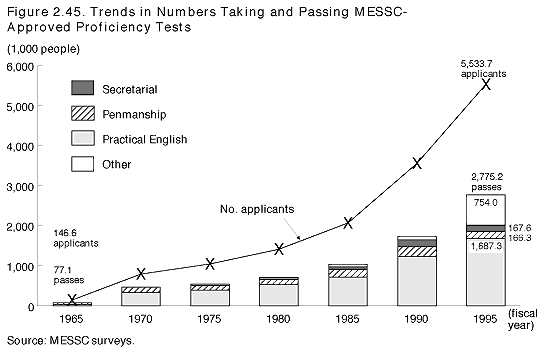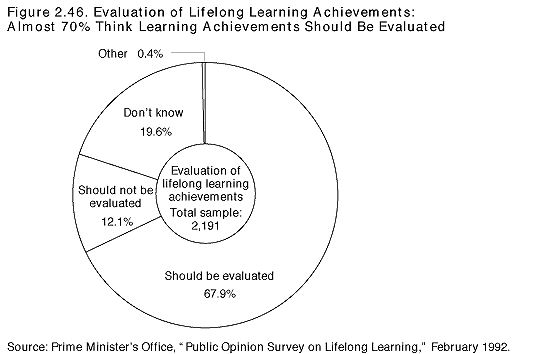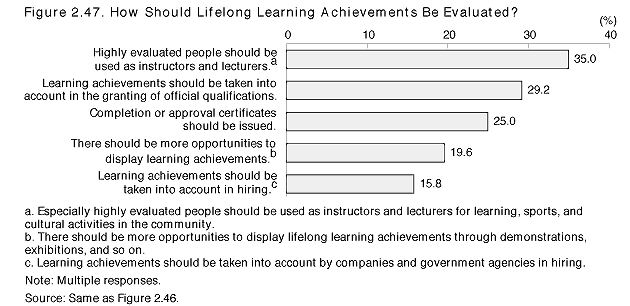| Home > Policy > White Paper, Notice, Announcement > White Paper > JAPANESE GOVERNMENT POLICIES IN EDUCATION, SCIENCE, SPORTS AND CULTURE 1996 > Priorities and Prospects for a Lifelong Learning Society Chapter 2 Section 3 1 | ||
Learning achievements in the school education context are recognized through the conferment of degrees or the granting of credits. Other forms of evaluation include the granting of licenses and diplomas based on various qualifications, examination passes, and the granting of eligibility to sit examinations in order to gain qualifications. There are also forms of recognition that are designed less to provide accurate assessments than to encourage learning activities. Completion and approval certificates fall into this category.
In school education, efforts are focusing on the creation of evaluation systems that recognize study outside the school in which a student is enrolled. Some upper secondary schools and universities now grant credits for studies at special training colleges and for success in proficiency tests approved by MESSC.
Another change relating to the evaluation of learning achievements in the school context was the establishment of the National Institution for Academic Degrees in 1991. The existence of this organization has made it possible to confer degrees under certain conditions, including completion by a graduate of a junior college or a college of technology of studies at a university or in an advanced course of a junior college or college of technology that is of a standard recognized by the National Institution for Academic Degrees, and completion of studies at a nonuniversity educational institution that is judged by the National Institution for Academic Degrees to be equivalent to a university or graduate school. In addition, the title "technical associate" can be conferred on a person who has completed a course in a professional training college (postsecondary course of a special training college) that meets certain requirements.
Under the university entrance qualification test system, university entrance qualification is granted mainly to people who graduated from lower secondary school but did not enroll in upper secondary school or to people who enrolled in upper secondary school but did not graduate. In fiscal 1995 university entrance qualification was granted to approximately 5,100 people under this system.
In addition to direct evaluation by the government through the granting of qualifications and licenses, evaluation is carried out by various government-approved or -designated institutions and organizations. The type and nature of evaluation approved or designated by the government vary widely. MESSC has approved 23 proficiency tests, and there is strong demand for evaluation through these tests. In fiscal 1995, 5,533,668 people took such tests, and 2,775,179 people passed. There has been a steady increase in the number of people taking and passing these tests ( Figure 2.45 ).
It used to be thought that skill assessment of white-collar workers was not feasible. In fiscal 1993, however, the Ministry of Labor introduced a job skill learning system (the Business Career Development Program) for this group, and completion certification examinations are now administered to verify that participants have acquired skills through education and training. Qualification is normally granted by the agency or organization responsible for the program in question. There has been criticism, however, that it is not always easy for potential learners to obtain accurate information on these programs.
Evaluation mechanisms do not always exist for learning activities relating to health, sports, hobbies, and general cultivation, which account for a substantial proportion of learning activities. This is probably because in these areas learning tends to be an end in itself, so that evaluation is not necessarily appropriate. This is apparent from the results of the 1992 "Public Opinion Survey on Lifelong Learning," which show that 67.9% of people thought that such activities should be evaluated, while 12.1% thought that evaluation was not appropriate and as many as 19.6% were uncertain ( Figure 2.46 ).
Respondents who stated that learning achievements should be evaluated were asked what form such evaluation should take. In response to this question 35.0% thought that people with especially highly evaluated learning achievements should be used as instructors and lecturers for learning, sports, and cultural activities in the community, 29.2% that learning achievements should be taken into account in the granting of official qualifications, and 25.0% that completion or approval certificates should be issued ( Figure 2.47 ).
Before people could be used as instructors, it would be necessary in some cases to carry out appropriate evaluation of their aptitude and ability as instructors. Although completion and approval certificates are widely used as a way of encouraging learning activities, it is not always clear whether a person has actually completed the activity. In many courses and programs run by prefectural and municipal governments evaluation is based on formalistic criteria, such as hours of attendance or the completion of assignments. This suggests that even among respondents who thought that learning achievements should be evaluated, most lacked a clear notion of the specific meaning of evaluation.



| Back to Top | MEXT HOME |